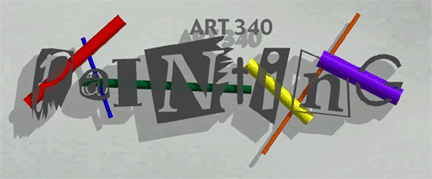REQUIRED MATERIALS: 1st semester students: Oil paints and supplies will be used during the first semester.
- COLORS: 2 oz. tubes of each:
- cadmium yellow medium
- ultramarine blue
- cobalt blue
- cadmium red medium
- alizarin crimson
- pthalo green
- raw siena
- burnt umber
- 4 oz. tube of titanium white
- BRUSHES: #9 or #10 flat, #4 or #5 round, #1 or #2 round, palette knife
- PALETTE: made of glass or a suitable palette pad
- GROUND & SUPPORTS: canvas panels and prestretched canvas as needed.
- RECEPTACLES: with lids for brush cleaning and to hold medium mixture
- CLEAN UP: paper towels and rags, bar of soap
- MEDIUM: 2.5 oz W&N Liquin Painting
- PAINT THINNER: 1 qt or more, odorless
- SKETCHBOOK: 9 x 12, for ideas
2nd, 3rd, and 4th semester students: Students who have completed the first semester of painting may select any painting medium.
Suggested supplies by medium:
OILS:
- MEDIUM: 8 oz each of damar varnish, pure gum turpentine, cold-pressed linseed oil
ACRYLICS:
- COLORS, BRUSHES, PALETTE, RECEPTACLES, CLEAN UP, SKETCHBOOK: same as oil paints.
- MEDIUM: 8 oz. Acrylic Gel Medium
BOTH: these supplies are for both media.
- GESSO: 1/2 gallon white acrylic gesso
- CANVAS: 2 yds. 48" wide
- MASONITE BOARD: 2- 18" x 24"
- GESSO BRUSH: 2" house painter brush
- WOOD: 2- 6' sections of 1"x 2" firring, 2- 6' sections 1" quarter round.
- SUPPLIES: wood glue, 1" brads
- STAPLE GUN: and staples
OTHER MEDIA: Will be discussed individually.
SECOND SEMESTER PROJECTS
Assignment 1: Monochrome Value Scales.
Using a 9" x 12" canvas panel, paint a 7-step monochromatic value scale in Ultramarine blue, cadmium red, and cadmium yellow. Black and white will be two of the values in each set.
Painting 1: Flat Space Still Life.
Using a 9" x 12" canvas panel as your support and ground, paint a still life with no variation in value. Use a variety of colors, but always keep the value the same. Deny volume without sacrificing the image. Working from life is recommended for this assignment.
Paper 1: Ancient Techniques.
Write a three-page paper about an ancient process and images produced by these techniques. The paper should have a minimum 3 sources and be accompanied by some images of artwork. Add a cover page and bibliography. Citations from sources should be included.
Painting 2: Ancient Techniques and the Portrait.
Choose either egg tempera, encaustic, or fresco and execute a painting (9" x 12" or larger) which incorporates portrait in some way. This painting will include preparation of grounds, as well as painting. Working from photographs is acceptable.
Assignment 2: Building Stretcher Frames.
Build two 18" x 24" stretcher frames and stretch canvas. This process will be explained in detail, demonstrated and much of the work will be done outside of the painting room. The resulting canvases will be used in Painting 4 and 5.
Paper 2: Symbol in Painting.
Write a two-page paper about a painting which is full of symbolism. The paper should have a minimum 3 sources and be accompanied by some images of artwork. Add a cover page and bibliography. Citations from sources should be included.
Painting 3: Symbolic Still Life in Glazes.
This work will be executed on an 12" x 18" panel. The intention here is to create a painting that implies symbolism or creates associations to its contents. Narrative works are encouraged. The use of glazes is a required technique in this painting.
Assignment 3: De Stihl Abstraction.
Do a drawing from life then show a series of five steps in which the form is simplified and distilled to its essentials. Feel free to move away from the De Stihl habit of using the rectangle as a core element.
Painting 4: Abstraction with Applied Texture.
Do an 18" x 24" painting on canvas from one of the steps in your De Stihl Abstraction, but add heavy texture, aggregate, collage materials, etc. to the surface of your work.
Painting 5: Non-Representational Painting.
Create associations with non-visual forms to compose a work. You will be organizing your own system for interpreting a non-visual form, i.e. music, literature, mathematics, etc..., into a visual one. Then use the system to make a painting on an 18" x 24" canvas. Use layers to create a "visual history" in the work. Refine your painting by abandoning the system and making the visual elements work better as a composition. Use the Fibonacci Sequence in some way.
Assignment 4: Strip Framing.
Construct a strip frame for either Painting 4 or 5 based on the instructions and demonstrations from class. This will take place prior to the Fall Student exhibition.
Painting 6: Manipulated Nature.
Examine the relationship between man and nature in either a positive or negative way. Depictions are open to either literal or metaphorical interpretations. The very nature of painting and painting materials can be questioned. Masonite panel support.
Painting 7: Love Letter.
Paint or construct a small-scale image as a love letter to a friend. This cannot be larger than 8" x 10" and can be interpreted from a variety of veiwpoints.
Painting 8: Mural Project.
The class will be participating in the painting of a large-scale mural. Students will be responsible for a small section. 4 th semester students will act as team coordinators setting working times. This project will introduce students to collaborative projects, public art, and basic organizational skills needed for large-scale works.
Back to top

